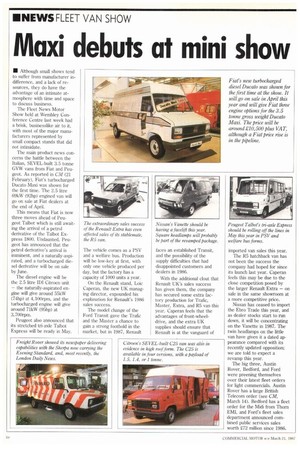Maxi debuts at mini show
Page 12

If you've noticed an error in this article please click here to report it so we can fix it.
• Although small shows tend to suffer from manufacturer indifference, and a lack of resources, they do have the advantage of an intimate atmosphere with time and space to discuss business.
The Fleet News Motor Show held at Wembley Conference Centre last week had a brisk, businesslike air to it, with most of the major manufacturers represented by small compact stands that did not intimidate.
The main product news concerns the battle between the Italian, SEVEL-built 3.5 tonne GVW vans from Fiat and Peugeot. As reported in CM (21 February), Fiat's turbocharged Ducat° Maxi was shown for the first time. The 2.5 litre 69kW (92hp) engined van will go on sale at Fiat dealers at the end of April.
This means that Fiat is now three moves ahead of Peugeot Talbot which is still awaiting the arrival of a petrol derivative of the Talbot Express 1800. Undaunted, Peugeot has announced that the petrol derivative's arrival is imminent, and a naturally-aspirated, and a turbocharged diesel derivative will be on sale by June.
The diesel engine will be the 2.5 litre IDI Citroen unit — the naturally-aspirated engine will give around 55kW (74hp) at 4,100rpm, and the turbocharged engine will give around 71kW (95hp) at 3, 70Orpm.
Peugeot also announced that its stretched tri-axle Talbot Express will be ready in May. The vehicle comes as a PSV and a welfare bus. Production will be low-key at first, with only one vehicle produced per day, but the factory has a capacity of 1000 units a year.
On the Renault stand, Loic Caperan, the new UK managing director, expounded his explanation for Renault's 1986 sales success.
The model change of the Ford Transit gave the Trafic and the Master a chance to gain a strong foothold in the market, but in 1987, Renault faces an established Transit, and the possibility of the supply difficulties that had disappointed customers and dealers in 1986.
With the additional clout that Renault UK's sales success has given them, the company has secured some extra factory production for Trafic, Master, Extra, and R5 van this year. Caperan feels that the advantages of front-wheeldrive, and the extra UK supplies should ensure that Renault is at the vanguard of imported van sales this year.
The R5 hatchback van has not been the success the company had hoped for since its launch last year. Caperan feels this may be due to the close competition posed by the larger Renault Extra — on sale in the same showroom at a more competitive price.
Nissan has ceased to import the Ebro Trade this year, and as dealer stocks start to run down, it will be concentrating on the Vanette in 1987. The twin headlamps on the little van have given it a dated appearance compared with its recently updated opposition; we are told to expect a revamp this year.
The big three, Austin Rover, Bedford, and Ford were preening themselves over their latest fleet orders for light commercials. Austin Rover has a large British Telecom order (see CM, March 14). Bedford has a fleet order for the Midi from Thorn EMI, and Ford's fleet sales department announced combined public services sales worth £72 million since 1986.




















































































